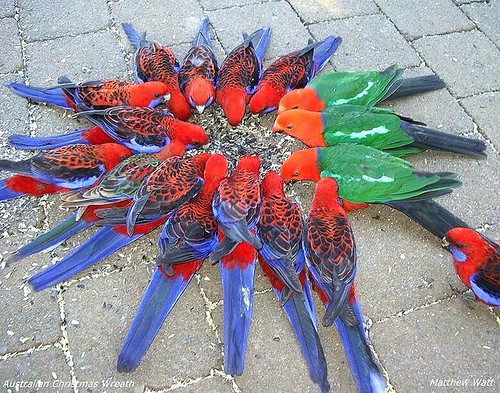tags: Crimson Rosella, Pennant's Rosella, Platycercus elegans, Australian King Parrot, Alisterus scapularis, birds, mystery bird, bird ID quiz
[Mystery birds] Australian King Parrots, Alisterus scapularis (3 on right), and Crimson Rosellas, sometimes known as Pennant's Rosella, Platycercus elegans (13 on top, left and bottom, also one in lower right side), photographed at Lamington National Park, west of the Gold Coast, Australia. The bird at the bottom is about to jump into the center, to the discontent of the other birds. [I will identify these birds for you in 48 hours]
Image: Matthew Watt, December 2009 [larger view].
Please name at least one field mark that supports your identification.


I promise to be good for Christmas, Grrl, so I will wait until my flight leaves tomorrow before I name both (perhaps obliquely for John and Adrian's benefit, although "scalloped scapula" comes to mind)!
David, my anatomy classes are a (long) way in the past, so are these Wavy-edged Shoulderblade Parrots then?
Well, the red ones are Crimson Rosellas. A beautiful bird but perhaps not quite as lovely as its more well known, multicolored Eastern cousin.
The green ones appear to be Australian King Parrots. The white stripe on the wing rules out the Moluccan subspecies.
I say Crimson Rosellas for the red ones too.
Adrian, I promised Grrl (and in fact I am positive about breaking both of these down to subspecies too!) so I will wait until tomorrow to confirm both, but "scalloped" is often used to describe all six of the Rosella species' back feathers and scapularis is the other's species descriptor...!
The Rosella at center left looks like it *could* be a different species.
Joshua, if you are referring to the green in the tail on one of the left hand Rosellas,(starting at the one-o'clock position moving counter-clockwise, #8), I think you'll find that characteristic of juveniles- note the slight greenish tinge to some of the wing feathers also
Sorry Joshua, that should have read "characteristic of juveniles and females" so also note possibles at #10, 12, 13...
For all those birders, twitchers, fowlers, and ornithologists:
We Wish You a Merryâªâ«â¢*¨*â¢.¸¸⥠¸¸.â¢*¨*â¢â«âª Christmasâªâ«â¢*¨*â¢.¸¸⥠¸¸.â¢*¨*â¢â«âª We Wish You a Merry âªâ«â¢*¨*â¢.¸¸⥠¸¸.â¢*¨*â¢â«âªChristmas ⥠⥠⥠We Wish You A Merry âªâ«â¢*¨*â¢.¸¸⥠¸¸.â¢*¨*â¢â«âªChristmas âªâ«â¢*¨*â¢.¸¸⥠¸¸.â¢*¨*â¢â«âª... And A Happy New Year!âªâ«â¢*¨*â¢.¸¸â¥
thanks david. happy holidays to you, too!
Thanks David, Seasons Greetings to you, Mrs and Mr Grrl and all the other people who make this blog such a fun place to come to.
The majority of these parrots (14) are indeed Rosellas, characterized by the scalloped back fathers, and one of the three Crimson Rosellas, Platycercus elegans: mostly red with blue cheeks, black-scalloped blue-margined wings, and a mostly blue tail⦠other than size, there is little difference between the genders on this except a possible greenish tinge to the upperside of the middle tail-feathers, so starting at one oâclock and moving counter-clockwise, #8 is very probably a female.
The three remaining are indeed Australian King Parrots, Alisterus scapularis, the males having a reddish-orange head, breast, and belly; green backs with a blue band between the green on the back and the reddish-orange on the neck; green wings with a pale green shoulder band; green tail; and blue rump; and one can just make out the beaks with a red upper mandible and black lower.
As far as subspecies are concerned, I think coloring and range here are pretty definitive- the Yellow Rosella, P. elegans flaveolus, is as described, where the crimson is replaced by yellow, and with the Adelaide Rosella , P. e. subadelaidae, crimson is replaced by a mixture of red, orange and yellow (also excluded because of range)⦠of the three Crimson Rosella subspecies, P. e. nigrescens is confined to Queensland's northeastern coast (the southernmost part of itâs range over 600 miles north of Lamington National Park) and P. e. melanoptera to Kangaroo Island, so this is the nominate Crimson Rosella subspecies, Platycercus elegans elegans.
With the Australian King Parrot, range is also definitive, with the smaller of the two identical subspecies, A. s. minor, also found in north Queensland around Townsville (about 1,000 miles north of where this photo was taken) and points north, so this is also the nominate subspecies of Australian King, Alisterus scapularis scapularis- to support this contention, compare the relative sizes of the two different species in the photo- Crimson Rosellas are about 14 inches long whereas Australian Kings average 17 inches long- the subspecies minor is said to be about 2 inches smaller than scapularis which would have made all of the birds above roughly the same size and I think the three we have are substantially larger.
I have a pic of a long billed currawong in Tasmania. I have never seen one before but my sister sent me a picture, is there such a bird?
I can send a picture of this bird to your site, but not really sure how to do this here. (Long billed currawong)